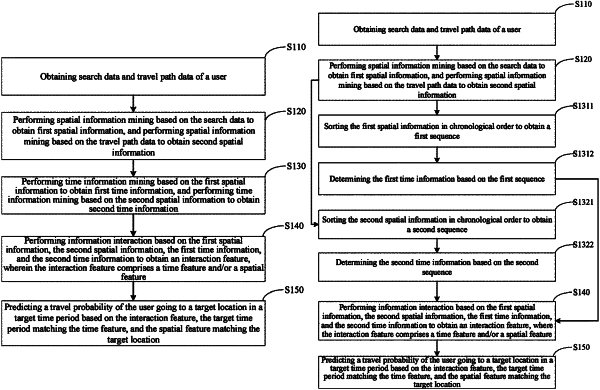| CPC G06N 20/00 (2019.01) [G01C 21/3446 (2013.01)] | 10 Claims |

|
1. A travel prediction method, comprising:
obtaining search data and travel path data of a user;
performing spatial information mining based on the search data to obtain first spatial information by:
determining longitude and latitude information of a user-searched location according to the search data; and
mapping the longitude and latitude information of the user-searched location to a high-dimensional space to obtain the first spatial information;
performing spatial information mining based on the travel path data to obtain second spatial information by:
determining longitude and latitude information of a user-passed location according to the travel path data; and
mapping the longitude and latitude information of the user-passed location to a high-dimensional space to obtain the second spatial information;
performing time information mining based on the first spatial information to obtain first time information by:
sorting the first spatial information in chronological order to obtain a first sequence; and
determining the first time information based on the first sequence;
wherein mining the first time information comprises using an attention mechanism and a long short-term memory (LSTM);
performing time information mining based on the second spatial information to obtain second time information by:
sorting the second spatial information in chronological order to obtain a second sequence; and
determining the second time information based on the second sequence;
performing information interaction based on the first spatial information, the second spatial information, the first time information, and the second time information to obtain an interaction feature, wherein the interaction feature comprises a time feature and a spatial feature, the performing information interaction step comprising:
taking the first spatial information and the second spatial information as the spatial feature;
taking the first time information and the second time information as the time feature; and
inputting the spatial feature and the time feature into a factorization machine model for a first-order interaction and a second-order interaction; and
predicting a travel probability of the user going to a target location in a target time period based on the interaction feature, the target time period matching the time feature, and the spatial feature matching the target location.
|